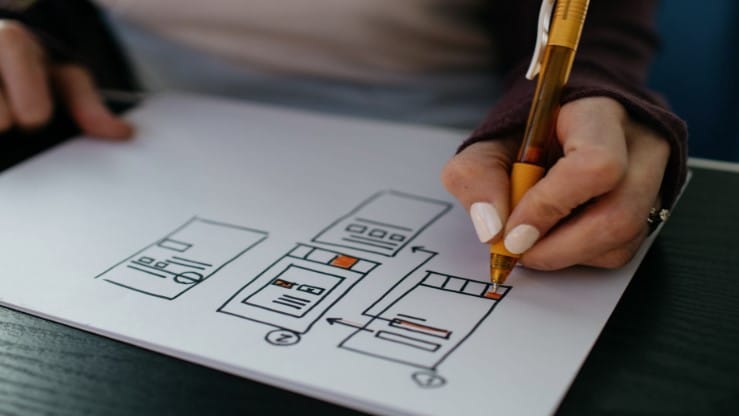Redesigning Your App: When, Why, And How To Do It Successfully

In today’s digital age, mobile applications have become an integral part of our lives. From social media to productivity tools, we rely on mobile apps for a variety of purposes. With the increasing competition in the app market, it’s crucial for app developers to constantly improve their app’s user experience and design to stay relevant and attract new users. This is where app redesign comes in.
App redesign refers to the process of revamping an existing mobile application’s design and user interface to make it more visually appealing, user-friendly, and functional. This may involve changing the app’s color scheme, layout, typography, iconography, and overall visual aesthetic.
Why is App Redesign Important?
App redesign is important for several reasons:
Firstly, it can help increase user engagement and retention. When an app is aesthetically pleasing and easy to use, users are more likely to spend more time on the app and keep coming back. This can ultimately lead to higher app ratings, better reviews, and increased downloads.
Secondly, app redesign can help keep up with changing trends and user preferences. User behavior and preferences are constantly evolving, and apps that fail to adapt risk becoming outdated and losing users. By redesigning an app, developers can incorporate new features, improve usability, and keep up with changing design trends.
Lastly, app redesign can help improve functionality and reduce user frustration. If an app’s design is cluttered, confusing, or difficult to navigate, users may become frustrated and give up on using the app altogether. Redesigning an app can help streamline its features and make it more intuitive to use, resulting in a better overall user experience.
How to Understand that Your App Needs a Redesign?
Sometimes it’s not easy to realize when it’s time to redesign your app. Here are some signs that indicate that your app may need a redesign:
Poor User Experience
If users are having a hard time navigating the app, experiencing technical issues or finding features, it may be time for a redesign. Negative reviews and high app abandonment rates could also indicate usability problems that require attention.
Outdated Appearance
App design trends change rapidly, and if your app looks outdated, users may perceive it as irrelevant or untrustworthy. You may want to consider a redesign if your app is using outdated fonts, colors, graphics, and interface elements.
Low User Engagement
If users aren’t spending much time on your app, aren’t returning frequently or aren’t performing desired actions such as purchasing, it may indicate that your app is not engaging enough or meeting users’ needs. A redesign can help increase engagement and user retention by improving usability and introducing new features.
Technical Limitations
Apps must keep pace with changes in technology and platform requirements to function correctly. An outdated or incompatible app may lead to crashes or errors, and these issues may be fixed by redesigning the app.
Increased Competition
The app market is highly competitive, and users have high expectations regarding app design and functionality. If your competitors are releasing apps with more advanced features, a better design, or a more intuitive user interface, it may be time to consider a redesign to stay ahead of the competition.
The above signs can indicate that it’s time to redesign your app, but it’s important to take user feedback, app analytics, and competitor analysis into account before making any significant changes.
When It Is Better Not to Redesign Your App?
Though redesigning an app seems to be a positive decision, sometimes it’s better not to redesign it. Here are some situations when redesigning your app may not be the best course of action:
Your app is performing well
If your app is meeting its goals, receiving positive feedback from users, and not experiencing any significant issues, there may not be a need for a redesign. In such cases, incremental updates may be sufficient to maintain the app’s performance and user satisfaction.
Tight budget
Redesigning an app can be expensive, and if you don’t have the budget to invest in a complete overhaul, it may not be worth it. In such cases, prioritizing updates based on user feedback and analytics may be a more cost-effective solution.
Lack of user feedback
If you don’t have enough user feedback or app analytics to support a redesign, it may be difficult to identify the specific issues that need to be addressed. In such cases, conducting user research and analysis to identify the root cause of user dissatisfaction may be necessary before proceeding with a redesign.
Short timeline
If you’re operating on a tight deadline, a complete redesign may not be feasible. In such cases, focusing on critical updates or quick fixes may be more practical and allow you to meet your deadlines.
User familiarity
If your app’s design is familiar and comfortable for users, changing it significantly may cause confusion and reduce engagement. In such cases, incremental updates may be a better approach to maintain familiarity while addressing usability issues.
Evaluating user feedback, analytics, budget, timeline, and familiarity with your app’s design can help you determine whether a redesign is the best course of action.

Steps Involved in App Redesign
Now that we have a clue when it’s better to redesign your app, let’s look at the redesigning process. Here are the main steps:
Identify the problem areas
The first step in app redesign is to identify the problem areas that need to be addressed. This can be done through user feedback, app analytics, and competitor analysis.
Set redesign goals
Once the problem areas have been identified, the next step is to set redesign goals. This involves defining what changes need to be made to the app’s design, and what specific goals the redesign aims to achieve.
Create a redesign plan
With the redesign goals in mind, the next step is to create a plan for how the redesign will be executed. This may involve creating wireframes, mockups, and prototypes of the new design.
Test the redesign
Before implementing the redesign, it’s important to test it thoroughly to ensure that it meets the goals set in step two. This may involve conducting user testing, A/B testing, and other forms of usability testing.
Implement the redesign
Once the redesign has been tested and refined, it’s time to implement it in the app. This may involve updating the app’s code, graphics, and other design elements.
Monitor and optimize
After the redesign has been implemented, it’s important to monitor user feedback and app analytics to see how the new design is performing. This can help identify any further areas for improvement and ensure that the redesign is meeting its goals.
By following the steps outlined above, you can create a more visually appealing, user-friendly, and functional app that will keep users coming back for more.
Conclusion
App redesigns can be a valuable investment for businesses looking to improve user experience, increase engagement, and stay competitive in the market. However, it’s important to carefully evaluate the specific circumstances of your app to determine whether a redesign is necessary and feasible. Defining your goals, analyzing user feedback, conducting user research, and collaborating with designers and developers can help you create a successful app redesign. By prioritizing user satisfaction and business goals, you can ensure that your redesigned app will provide value and drive success.





